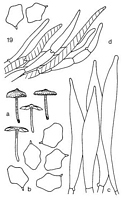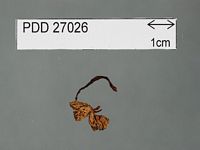|
 Entoloma brunneolilacinum Entoloma brunneolilacinum
BiostatusPresent in region - Indigenous. Endemic
Images (click to enlarge)
Caption: Entoloma brunneolilacinum Hk. (holotype): a. carpophores. b. spores. c. cheilocystidia.
d. cuticle. | 
Caption: Dried type specimen
Owner: Herb PDD |
Article: Horak, E. (1973). Fungi Agaricini Novazelandiae I-V. Beihefte zur Nova Hedwigia 43: 200 p.
Description: Pileus
15-25 mm diam., hemispherical at first or convex with an umbo, later becoming
umbonate or plano-convex, dark brown with distinct lilac tinge, colour fading
in aged carpophores, densely squamulose or scaly, strongly striate, hygrophanous,
dry. Lamellae (L 10-15, l 3), adnate or emarginate, grey or dark beige, turning
brownish-pink with lilac tinge, gill edge even and concolorous. Stipe 15-30
x 2 mm, cylindrical, concolorous with pileus, innately fibrillose, dry, fistulose,
solitary. Context dark brown, membranous. Odor acidulous. Taste not distinctive.
Spores
11-12 x 7-9.5 µm, 6-sided. Basidia 35-45 x 12 µm, 4-spored. Cheilocystidia (and
pleurostidia) 90-140 x 12-16 µm, awl-shaped or fusoid, apically tapering to
a rounded tip, membrane thin-walled and hyaline. Caulocystidia none. Cuticle
a trichoderm of fasciculate, cylindrical hyphae (8-15 µm diam.), terminal cells
conical, with brown plasmatic pigment. Clamp connections abundant.
Habitat: On
soil in forests (under Nothofagus menziesii, Leptospermum scoparium).
New Zealand.
Notes: Macroscopically
E. brunneolilacinum resembles E. acuticystidiosum Hk. or E.
squamiferum Hk. but the spores are distinctly different from those of these
taxa. Because of its lilac tint this species could be confused with E. porphyrescens
Hk., but the spores, cystidia and the size of the carpophores clearly distinguish
the two fungi.
|